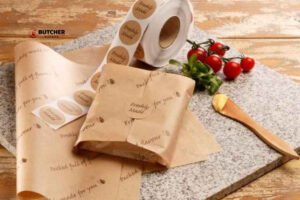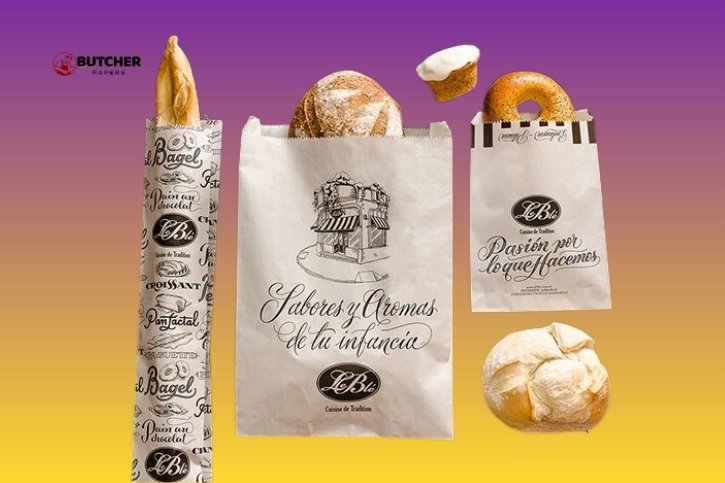In every kitchen, commercial or home, there is a product that can help prevent food from sticking, improve the quality of the food, and make cleanup easier. The versatility of parchment paper makes it a must-have for food wrapping, baking and roasting. It lets cooks focus on their creativity and precision, without having to worry about sticking or messing up.
Whether you are baking macarons, roasting vegetables, or wrapping sandwiches to be delivered, parchment paper will ensure consistency and ease. It’s a favorite of chefs, home cooks and bakers because it offers heat resistance, nonstick performance and safety.
Butcherpapers makes it easy for you to find premium parchment sheets and rolls suitable for many kitchen tasks. They are durable, food safe, and eco-friendly.
What is Parchment Paper
Parchment is a non-stick, heat-resistant paper that’s coated with silicone. It resists grease and moisture. The design of the paper allows it to resist temperatures between 420 and 450degF without compromising food safety. Parchment paper can be used in the oven and microwave, unlike wax paper which can catch fire or melt.
The versatility of the product is apparent in its many formats, such as:
- Sheets are ready-to-use in baking trays and loaf pans
- Cut rolls to size for commercial or custom kitchens
- Pre-cut liners are perfect for standard tray sizes used in bakeries and restaurants
The silicone coating reduces the amount of oil or butter needed and speeds up cleanup. The smooth surface helps to prevent fragile items such as cookies and pastries from tearing.
The Composition of Parchment Paper and its Manufacturing
Paper parchment is typically made of cellulose fibers derived from wood. The fibers are then treated with sulfuric acid, zinc chloride or a combination of both to give the paper its grease and heat resistance.
Then, both sides are coated with a thin film of silicone food grade. This coating:
- Non-stick surfaces are guaranteed
- The paper becomes moisture resistant
- Increased durability at high temperatures
The manufacturing process of parchment paper makes it both environmentally friendly and safe to use for direct food contact. There are many options for environmentally friendly kitchen solutions, including unbleached and natural products.
There are many types of parchment paper
Parchment paper sheets
They are perfect for small commercial kitchens and home bakers. These sheets are easy to use, reduce prep time and ensure uniform results. They can be used for lining cookie sheets, roasting trays, cake pans or roasting trays.
Measure trays carefully before cutting out sheets. This will help you avoid burning the overhangs in the oven.

Rolls of Parchment Paper
The rolls of parchment are perfect for large ovens, custom applications, and bakery trays. The rolls can be cut to fit the trays precisely, which reduces waste and ensures efficiency in professional kitchens.
Non-Stick Parchment
These coatings are ideal for foods that stick, such as caramel, sugary cookies, and chocolate. They reduce the amount of residue and maintain the appearance of baked goods.
Greaseproof Parchment
It is ideal for foods that are oily, such as bacon, pastries or roasted meats. It keeps pans and trays clean by preventing oil from soaking in.
Use Parchment Paper for its Benefits
- The food slides off the pan easily, without any additional oil or sprays
- Even baking: promotes uniform heat distribution in cookies, pastries and breads
- After baking or roasting, there is no need to scrub the trays.
- Moisture Retention: Prevents baking goods from drying out and keeps them soft.
- Food Safety: Silicone is FDA approved, and it’s chemical-free
- Versatility: Can be used in microwaves, ovens and as a food wrapper
When baking croissants or macarons on a tray lined with parchment, they will retain their shape and not stick to the tray.
Parchment Paper vs Wax Paper Aluminum Foil
| Features | Parchment Paper | Wax Paper | Aluminum Foil |
| Heat Resistance | Temperatures up to 450degF | Low melting point | High-quality |
| Non-Stick | Yes, | Limited | No, |
| Food Safety | Yes, | Yes, | Yes, |
| Best Use | Baking, cooking and roasting | Cold-preparation wrapping | Roasting and grilling |
Aluminum foil is best for roasting at high heat. Wax paper is good for cold preparation. Parchment paper is the best choice for baking and cooking.
How to use parchment paper in baking and cooking
- Line cake pans and cookie sheets
- Wrapping vegetables or fish to steam
- Rolling out the dough will prevent it from sticking
- Bake sticky desserts like caramel, macarons or meringues
- Takeaway sandwiches and pastries wrapped in pastry
Save time by pre-cutting parchment sheets into standard sizes.
Related Article: Parchment paper for baking & food packaging
Parchment paper for roasting and cooking
The benefits of using parchment paper to roast food are numerous:
- Food will not stick to the tray
- Ensures even cooking
- Use less butter or oil
- Simple tray cleaning
For example, roasting a chicken whole on parchment-lined trays will ensure that juices remain in the tray and do not burn onto the pan. This results in tender meat with easy cleanup.
Parchment paper in the Microwave
The parchment paper can be heated in the microwave without causing food to spill. It can help to retain moisture and improve the texture of leftovers.
Useful Tips for Microwaves:
- Avoid crumpling and folding too tightly
- Only use parchment sheets that are microwave safe
- Use metallic inks or designs only for a limited time.
Eco-Friendly Alternatives
Most parchment papers today are unbleached and chlorine-free. They also biodegrade. Eco-friendly parchment papers reduce landfill waste and maintain kitchen safety.
When purchasing parchment paper, look for the “eco-friendly” or “unbleached eco” label.
Parchment Paper vs Printing Parchment
The two are often confused. Differences:
- Baking parchment: Food-safe, non-stick, heat-resistant
- Printing parchment is decorative, but not suitable for microwaves or ovens
Always make sure that the products you use in your kitchen are of food grade.
Professional Applications
- Bakeries: Line trays, wrap pastries, separate layers
- Restaurants and cafes: packaging sandwiches, lining service trays
- Food Trucks & Catering – Easy transport and presentation
- Home baking: cookies, breads and desserts
Professionally using parchment paper saves time and enhances the presentation of food. It also ensures hygiene.
Related Article: Paper for Bakery Baking Papers, Sheets & Parchment
Conclusion:
The parchment paper is a must-have for every kitchen. It is non-stick, heat resistant, food safe, and simplifies cleanup. Parchment paper is the best choice for baking delicate pastries or vegetables, or even wrapping food to take away.
Butcherpapers make it simple to find high-quality rolls and sheets. They offer options that are durable, eco-friendly and versatile. Parchment paper is a safe and practical kitchen solution that can be used in both home kitchens and professional bakeries.
FAQs
Can parchment paper be used in the oven
You can use it up to 420degF, depending on the brand.
Can parchment paper be re-used?
It can be used once or twice if it is not heavily oiled.
Is parchment paper biodegradable
The majority of food-grade parchment paper is biodegradable.
Can parchment paper be microwaved?
It is safe to use in the microwave and it prevents spills.
Can parchment paper replace aluminum foil?
Yes, for baking and steaming. For grilling and high temperatures, foil is best.

